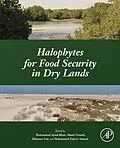Halophytes for Food Security in Dry Lands addresses the concerns surrounding global food scarcity, especially focusing on those living in arid and dry lands The book touches on food crises in dry regions of the world and proposes halophytes as an alternate source of consumption for such areas. Halophytes, those plants that thrive in saline soil and provide either food source options themselves, or positively enhance an eco-system's ability to produce food, and are thus an important and increasingly recognized option for addressing the needs of the nearly 1/6 of the world's population that lives in these arid and semi-arid climates. Including presentations from the 2014 International Conference on Halophytes for Food Security in Dry Lands, this book features insights from the leading researchers in the subject. It is a valuable resource that includes information on the nutritional value of halophytes, their genetic basis and potential enhancement, adaption of halophytes, and lessons learned thus far. - Provides comprehensive coverage of the importance and utilization of halophytes to compensate the demand of food in whole world especially in the dry regions - Contains insights from ecological to molecular fields - Includes edible halophytes as well as those that enhance food-producing eco-systems - Presents information for improving abiotic stress tolerance in plants
Autorentext
Dr. Munir Ozturk (Ph.D) holds Ph.D. and D.Sc. degrees from the Ege University, Turkiye. He is currently acting as the "Vice President of the Islamic World Academy of Sciencesand is also Fellow of the Islamic World Academy of Science. Dr. Ozturk has been honored as the "Foreign Fellow Pakistan Academy of Science. He has served at the Ege University-Turkiye for more than 50 years in different positions, has been Founder Director of the Centre for Environmental Studies, Ege University, and Chairman of the Botany Department and Director of the Botanical Garden. Sideritis ozturkii and Verbascum ozturkii are 2 newly recorded endemic plant species from Turkiye in his name. His fields of scientific interest are; pollution & biomonitoring; biosaline agriculture; plant ecophysiology, medicinal and aromatic plants conservation. Dr. Ozturk has published almost 60 books with internationally known publishers including Springer, Elsevier,Taylor & Francis, Wiley and few others. His biodata shows more than 90 book chapters and 200 papers in international journals; 120 with impact factor. He has also presented 125 papers at the International Meetings and 85 at the National Meetings. Dr. Munir has served as a guest editor for more than 13 journals; holds more than 20 Memberships of "Institutions and Professional Bodies; has been recognized by more than 12 "National and International Bodies; has received fellowships from the globally recognized Alexander von Humboldt Foundation, Japanese Society for Promotion of Science, and the National Science Foundation of the USA. He has also worked as consultant fellow at the Faculty of Forestry, Universiti Putra Malaysia, Malaysia; and as Distinguished Visiting Scientist at International Centre for Chemical and Biological Sciences, ICCBS-TWAS, Karachi University, Pakistan.
Klappentext
Halophytes for Food Security in Dry Lands addresses the concerns surrounding global food scarcity, especially focusing on those living in arid and dry lands
The book touches on food crises in dry regions of the world and proposes halophytes as an alternate source of consumption for such areas. Halophytes, those plants that thrive in saline soil and provide either food source options themselves, or positively enhance an eco-system's ability to produce food, and are thus an important and increasingly recognized option for addressing the needs of the nearly 1/6 of the world's population that lives in these arid and semi-arid climates.
Including presentations from the 2014 International Conference on Halophytes for Food Security in Dry Lands, this book features insights from the leading researchers in the subject. It is a valuable resource that includes information on the nutritional value of halophytes, their genetic basis and potential enhancement, adaption of halophytes, and lessons learned thus far.
- Provides comprehensive coverage of the importance and utilization of halophytes to compensate the demand of food in whole world especially in the dry regions
- Contains insights from ecological to molecular fields
- Includes edible halophytes as well as those that enhance food-producing eco-systems
- Presents information for improving abiotic stress tolerance in plants
Inhalt
-
Characterization and function of sodium exchanger genes in Aeluropus lagopoides under NaCl stress
-
Multi-temporal soil salinity assessment at very detailed scale for discriminating halophytes distribution
-
Nutritional value of Chenopodium quinoa seeds grown under saline conditions
-
Halophytes and saline vegetation of Afghanistan, a potential rich source for people
-
Overcoming barriers to implementing high salinity agriculture in the Gulf
-
Carbon mitigation: a salt marsh ecosystem service in times of change
-
Exploiting plants from extreme environments: world enough, but perhaps not time
-
The importance of mangrove ecosystems for nature protection and food productivity: Action of UNESCO's Man and the Biosphere Programme
-
The Potential Use of Halophytes for the Development of Marginal Dry Areas in Morocco
-
Transcriptome and proteome analysis of genes involved in salt tolerance in the halophyte Suaeda fruticosa
-
Sustainable diversity of crops - livestock production system based on optimal utilization in Sinai: A case study
-
Cell suspension culture of the halophyte Cakile maritima: Establishment and response to salinity
-
Exogenous chemical treatments to improve salt tolerance of cash crop halophytes
-
Food and water security for Qatar: a new paradigm
-
Genetic and environmental management of halophytes for improved livestock production
-
Drought and salinity differently affect germination of "Chenopodium quinoa Willd"
-
Plant community and germination of selected halophytes of Sundarbans mangrove forest and diversity
-
Halophytic Plant Diversity of a Unique Habitat in Turkey - Tuzluca Salt Mine Cave
-
Halophytes a possible alternative to desalination plants: prospects of recycling saline wastewater during Coal Seam Gas operations
